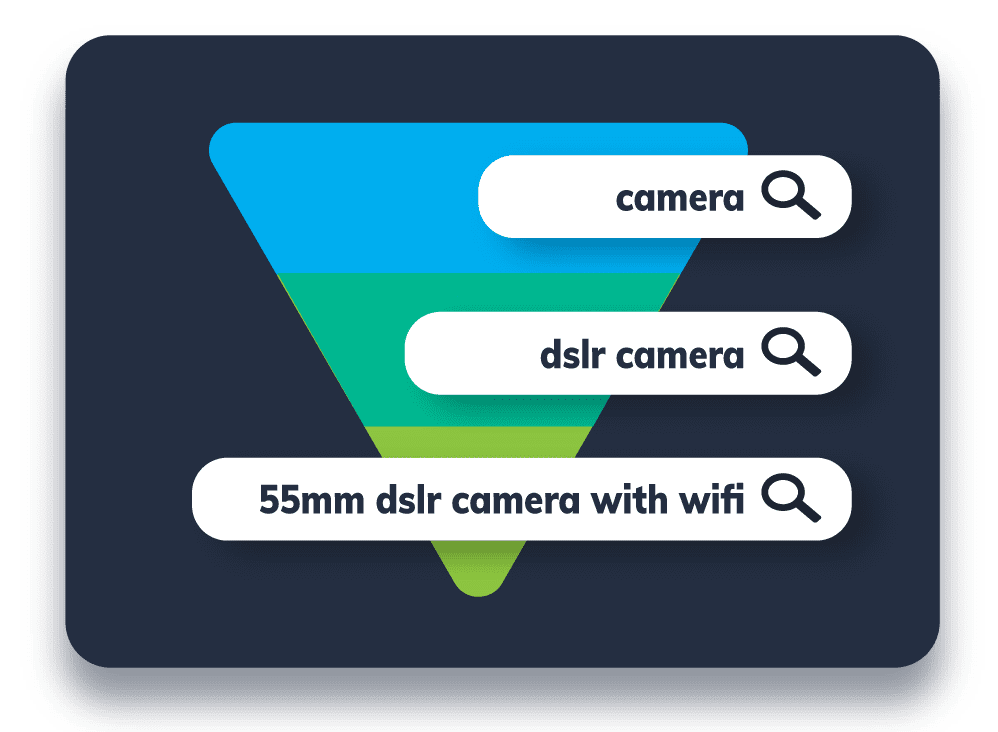Want to dramatically improve the profitability and efficiency of your Google Shopping campaigns? Negative keywords can help you direct your ad spend with precision—leading to less wasted ad spend, and more profit for your business! Omnitail’s negative keyword strategy for Google Shopping is designed specifically to help you maximize profit for your business.
Interested in seeing how it works? Read on to learn our method for query segmentation on Google Shopping using negative keywords, so you can start growing your Google Shopping profit today!

Don’t Pay for Search Terms That Don’t Convert

Using your sales and query data we segment our clients’ search terms into 3 categories: generic, qualified, and item-specific. These categories are segmented using negative keywords and are segmented according to the value the queries bring to your business. For example, in the picture above, the generic query is “camera”. Someone who searches for “camera” is a lot less valuable to your business than someone who searches the term “55mm DSLR Camera with Wifi”. Someone who searches for a long-tail item-specific query such as that, has a solid idea of which product they want to buy—and is likely to purchase soon.
Other agencies bid the same amount for all of these categories, resulting in wasted ad spend. With our strategy, you can lower bids on low value terms and bid more aggressively on terms that are likely to convert. Time and time again, this strategy has radically increased profit for our clients with little change to total media spend—to see what our strategy can do for your campaigns! Get a free analysis of your Google Shopping campaigns today.

Our Overall Google Shopping Strategy
Now that you have an idea of how our query segmentation strategy works, let’s take a look at the other factors that help you maximize profit in your Google Shopping campaigns. The three factors that will drastically change your Google Shopping campaigns (other than query segmentation) are product feed optimization, a profit-driven strategy, and multi-touch attribution.

1. Product Feed Optimization
Great campaigns begin with great data. We take your product feed through a 6-phase, 77-step data feed optimization process, revising feed attributes to ensure optimal performance. With in-house tools, we automatically add your new products in the feed to your account structure, so each of your products has a chance to succeed!
You can also optimize your feed! Check out our guide to feed optimization here.

2. Profit-Driven Bid Management
At Omnitail, we manage your account’s bids according to operating profit—the only metric that accounts for both efficiency and sales volume. We take into account your cost of goods and other variable overhead, strategically driving spend toward the campaigns and ad groups that provide the most incremental profit for you!
Learn more about the benefits of using profit as your core KPI over traditional metrics like ROAS, CPO/CPA, and A/S in our whitepaper: Breaking Up With ROAS.

3. Multi-Touch Attribution
We believe our industry suffers from a lack of transparency and accountability —especially when it comes to reporting. That’s why we always look at your account using at least two attribution models (conservative and generous) — so you can track the full impact of your campaigns’ performance.

Negative Keywords Have a Positive Impact
Our query segmentation strategy and negative keyword strategy has been apart of our clients success stories time and time again—and is an integral part of our Google Shopping management. Not sure if this strategy will work for your business? Here’s a sampling of success stories we think you’ll like (across different industries):

Start Using Negative Keywords on Google Shopping
Want to take our strategy for a test drive? Explore Omnitail’s Google Shopping strategy in-depth, and learn how to segment your keywords by query intent using negative keywords. See our strategy in action, using anonymized data and real examples! Here’s our complete guide to running an n-gram analysis so you can implement negative keywords in your Google Shopping campaigns.
Get the guide: N-Grams: The Path to Effective Keyword Targeting in Google Shopping.









